Southwest Airlines is not used to losing money.
On Tuesday, it announced plans to raise an additional $2.5 billion through the sale of 55 million shares and a $1 billion bond offering after reporting its first quarterly loss in nearly a decade.
The Dallas-based carrier said it lost $94 million in the first quarter because a major decline in passenger bookings and a spike in cancellations beginning in late February led revenue to fall 17.8% to $4.2 billion. Freight revenue fell 7.1% to $39 million. The loss was much smaller than that of United Airlines ($2.1 billion) or Delta Air Lines ($607 million pre-tax loss before adjustments), both of which have much more extensive international networks that were exposed much sooner to the travel downturn caused by the coronavirus.
But Southwest (NYSE: LUV) said it expected revenue declines of 90% to 95% in April and May, refusing to extend its outlook any longer because the volatile market makes it too difficult to ascertain trends.
“We entered this crisis prepared with the U.S. airline industry’s strongest balance sheet and most successful business model. While the impact of the pandemic is unprecedented, we believe demand for air travel will rebound. And, we intend to emerge with ample liquidity and an unwavering focus” to once again provide reliable, low-cost air travel, Chairman and CEO Gary Kelly said in a statement.
Officials said they plan to cut back capacity by up to 70% through May, with further reductions in the flight schedule through July expected. The airline likely will need to reduce available seats even more given that it is still flying 40% of its schedule while demand is down at least 90%. Its major U.S. competitors have cut domestic capacity by 90%. Southwest said it expects single-digit load factors through May.
The airline has less than half of its 742 aircraft in long-term storage, not including 34 Boeing 737 MAX aircraft that were grounded last year for safety reasons.
Last year Southwest was chomping at the bit for more MAX aircraft because business was strong and the planes were needed to expand route offerings. Now, Southwest doesn’t need the airplanes and officials said they are negotiating with Boeing on revising the existing order and the delivery schedule.
Boeing has produced another 27 MAX aircraft for Southwest that cannot be delivered because of the no-fly order. Previously, the company agreed to take no more than 48 aircraft through the end of 2021 and take less than 27 MAX aircraft this year should the MAX be recertified by the Federal Aviation Administration. The MAX is more fuel efficient than older 737 models and if Southwest were to receive some airplanes it could substitute them for older aircraft.
According to aviation researcher Cirium, 9% of Southwest’s fleet is older than 20 years.
Deferring orders and deliveries is one of many steps Southwest and other airlines are taking to preserve cash. Southwest has slashed more than $2 billion in operating costs from its 2020 budget by cutting non-essential spending and executive salaries, modifying vendor payment terms and implementing voluntary time-off programs for workers. It also cut capital spending by more than $1 billion by canceling or deferring hundreds of projects.
The belt-tightening has halved the company’s daily cash burn to about $30 million to $35 million from prior estimates. Delta last week said it was using up $50 million in cash per day.
Southwest entered the year with a strong balance sheet of $4.1 billion in cash and short-term investments, and a debt-to-capital ratio of 24%. It has since raised $6.8 billion through $5.2 in debt financing and $1.6 billion from the U.S. Treasury Department (out of $3.3 billion total) as part of the federal program to preserve payrolls through September. Officials say they plan to apply for a $2.8 billion secured loan through the Treasury Department.
With $9.3 billion in liquid assets, and another $6 billion of unencumbered aircraft, Southwest is better positioned than many carriers to weather the COVID-19 crisis, analysts say.
Southwest has 60,000 employees and claims it has never laid off workers in its 49 years of existence. In a message to staff last week, Kelly suggested that practice might end this year.











